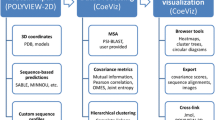Abstract
A recent report by Bahar et al. [(1997), Proteins 29, 172–185] indicates that the coupling effects among different amino acid components as originally formulated by K. C. Chou [(1995), Proteins 21, 319–344] are important for improving the prediction of protein structural classes. These authors have further proposed a compact lattice model to illuminate the physical insight contained in the component-coupled algorithm. However, a completely opposite result was concluded by Eisenhaber et al. [(1996), Proteins 25, 169–179], using a different dataset constructed according to their definition. To address such an intriguing controversy, tests were conducted by various approaches for the datasets from an objective database, the SCOP database [Murzin et al. (1995), J. Mol. Biol. 247, 536–540]. The results obtained by both self-consistency and jackknife tests indicate that the overall rates of correct prediction by the algorithm incorporating the coupling effect among different amino acid components are significantly higher than those by the algorithms without counting such an effect. This is fully consistent with the physical reality that the folding of a protein is the result of a collective interaction among its constituent amino acid residues, and hence the coupling effects of different amino acid components must be incorporated in order to improve the prediction quality. It was found by a revisiting the calculation procedures by Eisenhaber et al. that there was a conceptual mistake in constructing the structural class datasets and a systematic mistake in applying the component-coupled algorithm. These findings are informative for understanding and utilizing the component-coupled algorithm to study the structural classes of proteins.
Similar content being viewed by others
REFERENCES
Bahar, I., Atilgan, A. R., Jernigan, R. L., and Erman, B. (1997). Understanding the recognition of protein structural classes by amino acid composition, Proteins 29, 172–185.
Chandonia, J. M., and Karplus, M. (1995). Neural networks for secondary structure and structural class prediction, Protein Sci. 4, 275–285.
Chou, K. C. (1995). A novel approach to predicting protein structural classes in a (20 -- 1)-D amino acid composition space, Proteins Struct. Funct. Genet. 21, 319–344.
Chou, K. C., and Zhang, C. T. (1995). Prediction of protein structural classes, Crit. Rev. Biochem. Mole. Biol. 30, 275–349.
Chou, P. Y. (1980). Amino acid composition of four classes of proteins, In Abstracts of Papers, Part I, Second Chemical Congress of the North American Continent, Las Vegas, Nevada.
Chou, P. Y. (1989). Prediction of protein structural classes from amino acid composition, In Prediction of Protein Structure and the Principles of Protein Conformation (Fasman, G. D., ed.), Plenum Press, New York, pp. 549–586.
Dubchak, I., Holbrook, S. R., and Kim, S.-H. (1993). Predicting protein secondary structure content: A tandem neural network approach, Proteins Struct. Funct. Genet. 16, 79–91.
Duda, R. O., and Hart, P. E. (1973). Pattern Classification and Scene Analysis, Wiley, New York, Chapter 2.
Eisenhaber, F., Frömmel, C., and Argos, P. (1996). Prediction of secondary structural content of proteins from their amino acid composition alone. II. The paradox with secondary structural class, Proteins Struct. Funct. Genet. 25, 169–179.
Farber, G. K., and Petsko, G. A. (1990). The evolution of α/β barrel enzymes, TIBS 15, 228–234.
Kabsch, W., Mannherz, H. G., Suck, D., Pai, E. F., and Holms, K. C. (1990). Atomic structure of the actin:DNase 1 complex, Nature 347, 37–44.
Kabsch, W., and Sander, C. (1983). Dictionary of protein secondary structure: Pattern recognition of hydrogen-bonded and geometrical features, Biopolymers 22, 2577–2637.
Klein, P., and Delisi, C. (1986). Prediction of protein structural class from amino acid sequence, Biopolymers 25, 1659–1672.
Levitt, M., and Chothia, C. (1976). Structural patterns in globular proteins, Nature 261, 552–557.
Mahalanobis, P. C. (1936). On the generalized distance in statistics, Proc. Natl. Inst. Sci. India 2, 49–55.
Mardia, K. V., Kent, J. T., and Bibby, J. M. (1979) Multivariate Analysis. Academic Press, London, pp. 322 and 381.
Metfessel, B. A., Saurugger, P. N., Connelly, D. P., and Rich, S. T. (1993). Cross-validation of protein structural class prediction using statistical clustering and neural networks, Protein Sci. 2, 1171–1182.
Murzin, A. G., Brenner, S. E., Hubbard, T., and Chothia, C. (1995). SCOP: A structural classification of protein database for the investigation of sequence and structures, J. Mol. Biol. 247, 536–540.
Muskal, S. M., and Kim, S.-H. (1992). Predicting protein secondary structure content: A tandem neural network approach, J. Mol. Biol. 225, 713–727.
Nakashima, H., Nishikawa, K., and Ooi, T. (1986). The folding type of a protein is relevant to the amino acid composition, J. Biochem. 99, 152–162.
Pillai, K. C. S. (1985). Mahalanobis D 2, In Encyclopedia of Statistical Sciences (Kotz, S., and Johnson, N. L., eds.), Wiley, New York, Vol. 5, pp. 176–181.
Rost, B., and Sander, C. (1994). Combining evolutionary information and neural networks to predict protein secondary structure, Protein Struct. Funct. Genet. 19, 55–72.
Sondek, J., and Shortle, D. (1990). Accomodation of single amino acid insertions by the native state of staphyloccocal nuclease, Proteins Struct. Funct. Genet. 7, 299–305.
Zhang, C. T., and Chou, K. C. (1992). An optimization approach to predicting protein structural class from amino acid composition, Protein Sci. 1, 401–408.
Author information
Authors and Affiliations
Rights and permissions
About this article
Cite this article
Zhou, GP. An Intriguing Controversy over Protein Structural Class Prediction. J Protein Chem 17, 729–738 (1998). https://doi.org/10.1023/A:1020713915365
Published:
Issue Date:
DOI: https://doi.org/10.1023/A:1020713915365




